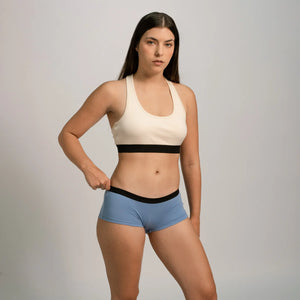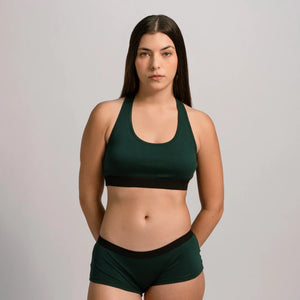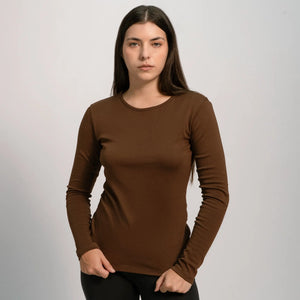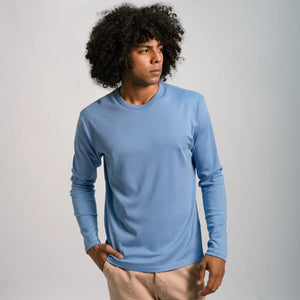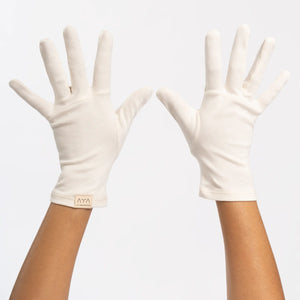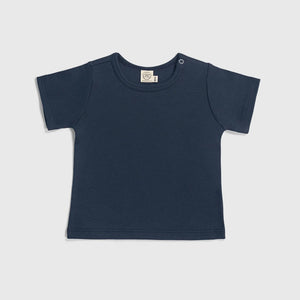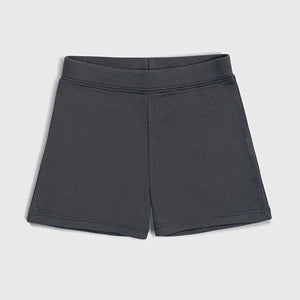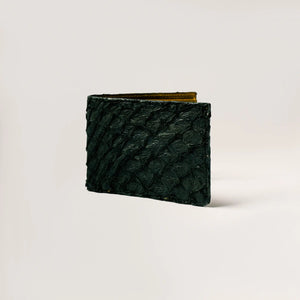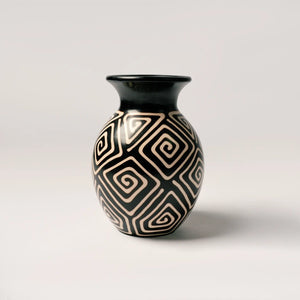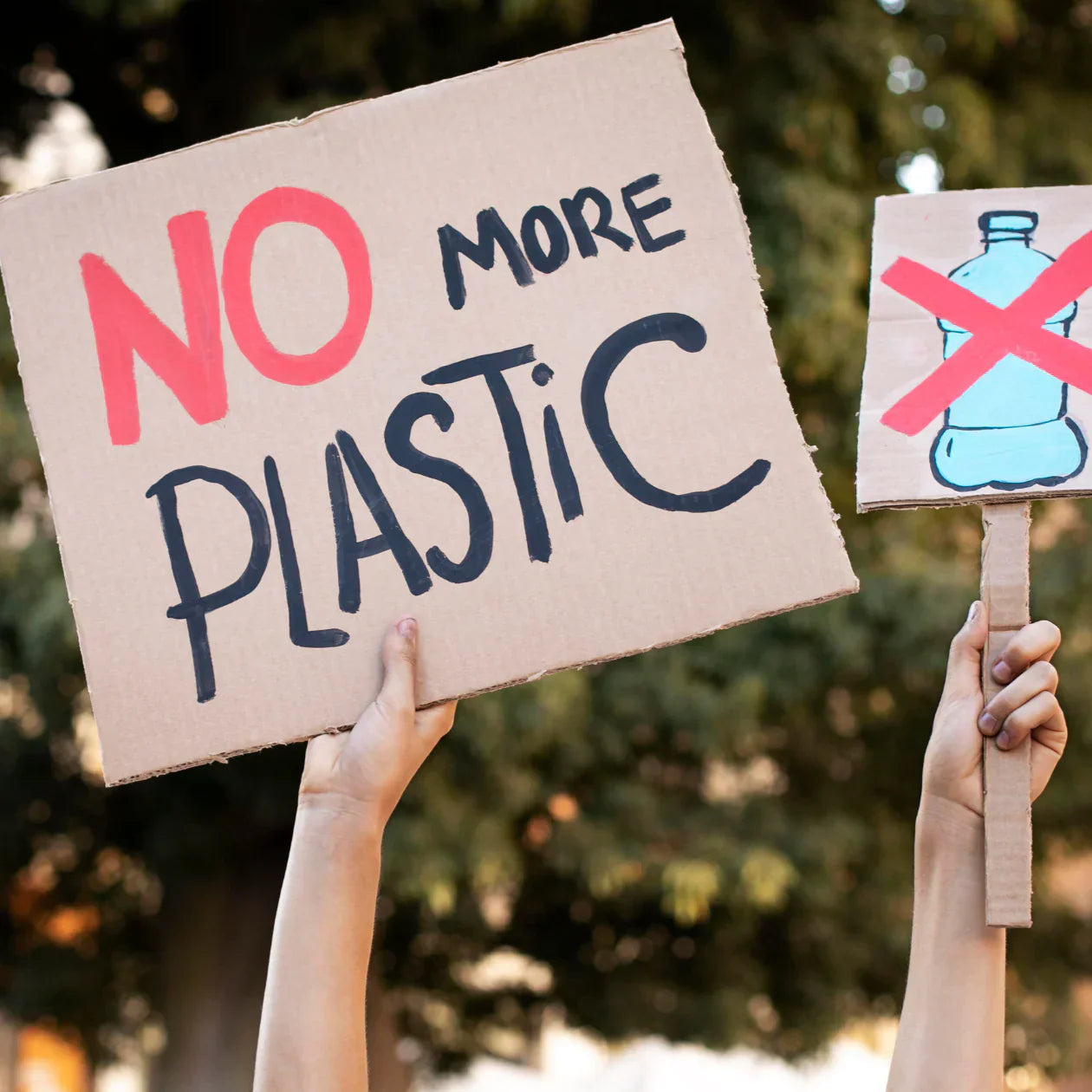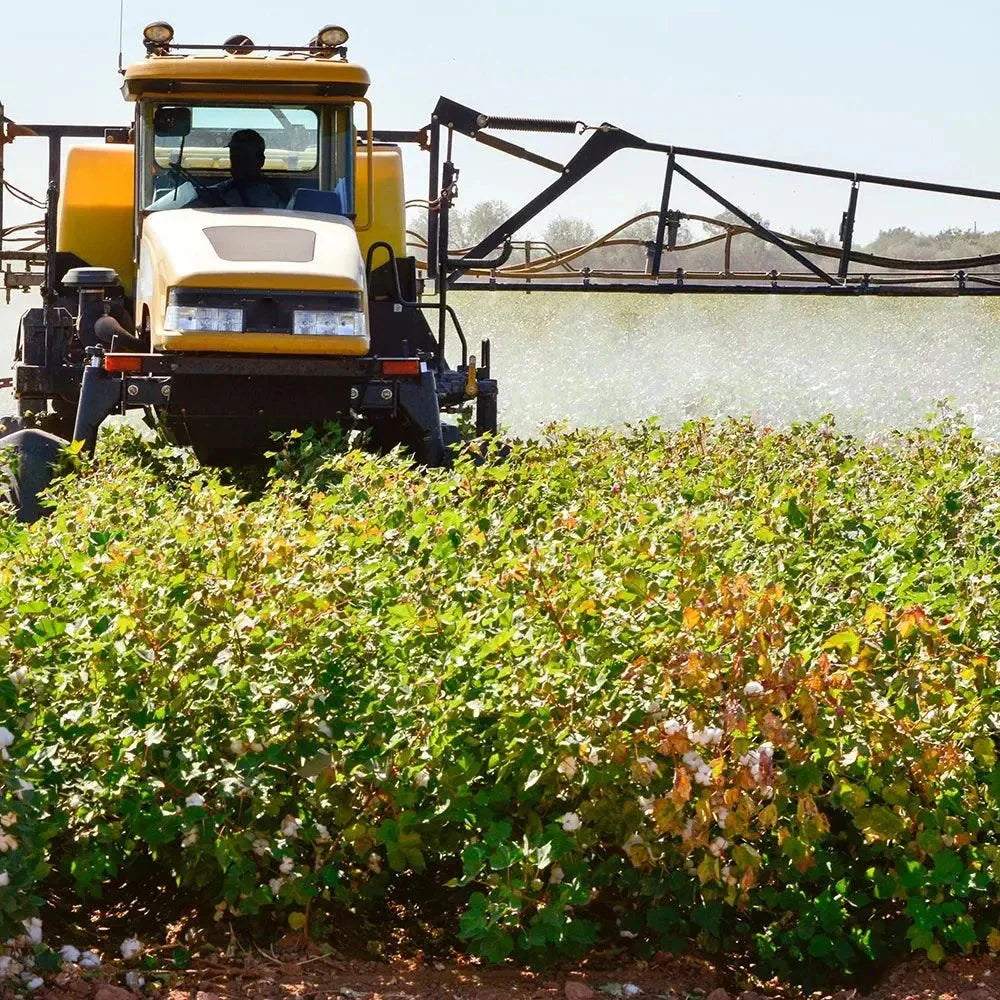Synthetic Fabrics vs. Organic Cotton:
How Clothing Impacts Your Skin Health
.
AYA | AUGUST 22, 2025
READING TIME: 6 minutes
By Jordy Munarriz
AYA | AUGUST 12, 2025
READING TIME: 4 minutes
By Jordy Munarriz
What Does Our Clothing Do to Our Skin?
Our skin is not only the largest organ of the body but also the most exposed. Every day, it interacts with the environment, pollutants, and—often overlooked—the textiles we choose to wear. The same piece of clothes is in constant and direct contact with skin, sometimes for more than 8 hours a day [1]. While fabrics are marketed primarily for their aesthetics, performance, or price, their role in dermal health is profound.
The global apparel market is dominated by synthetic fibers such as polyester, nylon, and spandex, which now account for more than 50% of production worldwide [2]. These materials are derived from fossil fuels and often enhanced with chemical treatments to improve performance. However, growing evidence links them to skin irritation, allergies, and even systemic absorption of harmful compounds.
This article explores the dermatological risks of synthetics, contrasts them with the benefits of organic cotton, and explains why choosing natural fibers is not just an environmental decision but also a health priority.
Why Synthetic Fabrics Can Irritate the Skin
Contact Dermatitis and Allergic Reactions
Synthetics like polyester and nylon are essentially plastics. They are produced from petrochemicals and often blended with additives such as dyes, flame retardants, and plasticizers. These additives can leach onto the skin, especially under heat and sweat.
Studies show that up to 60% of individuals with sensitive skin report rashes or contact dermatitis after wearing synthetic clothing in warm or humid conditions [3]. The selection of fabrics for patients with atopic dermatitis shows that most report worsening symptoms when wearing synthetic clothing, attributing it to mechanical irritation, sweat buildup, and the presence of chemicals [4,5].
A textile research study also highlighted how nylon stockings were linked to erythema and allergic rashes in women, while cotton alternatives did not provoke similar responses [6]. These findings underline that synthetics are not neutral surfaces—they are active irritants for many.
The Breathability Problem
Skin thrives when it can regulate heat and humidity. Natural fibers like cotton wick moisture away, while synthetics tend to trap heat and sweat. This occlusive environment weakens the skin barrier and creates conditions for intertrigo, fungal infections, and bacterial overgrowth [7].
Case reports have documented textile workers exposed to polyester dust developing burning, itching, and cracked skin [8]. This shows that the risk extends beyond casual wear—synthetics are problematic across contexts, from daily use to occupational exposure.

Why Organic Cotton Protects Skin
Organic cotton fibers have a hollow, porous structure that allows airflow and absorbs moisture, preventing the heat buildup associated with synthetic clothing [9]. This is especially critical for people with eczema, psoriasis, or sensitive skin, who benefit from reduced sweat retention.
A randomized trial found that after just three weeks of nighttime use, skin hydration was significantly higher when wearing cotton pajamas compared to polyester—an indication of better skin barrier function and reduced inflammation [5]. This highlights the importance of choosing breathable fabrics for daily comfort and skin health.
Conventional Cotton vs. Organic Cotton
The distinction between conventional and organic cotton is essential—not only for the environment, but also for the people who grow it and the consumers who wear it. Conventional cotton is one of the most pesticide-intensive crops in the world, accounting for roughly 16% of all global insecticide use [10]. Residues from these chemicals can remain on the fibers, potentially irritating sensitive skin or contributing to long-term health risks.
In Burkina Faso, for instance, 100% of conventional cotton farmers reported using synthetic pesticides, with many experiencing acute symptoms such as skin irritation, respiratory issues, and eye discomfort [11]. In contrast, organic cotton farming avoids these highly toxic chemicals, which drastically reduces the health risks for workers and the presence of harmful residues on the final product.
However, this doesn’t mean organic farmers are completely free from all forms of exposure. Organic cotton cultivation allows the use of natural insecticides and herbicides—such as neem extract or plant-based oils—which are far less harmful than synthetic options. While generally safe, these substances may still cause mild and temporary effects like eye or skin irritation in certain conditions, especially if not handled with appropriate protective gear [12].
Importantly, studies show that these effects are not chronic or long-lasting, and workers do not suffer from the severe or irreversible health conditions associated with conventional pesticide exposure [12].
Beyond the fields, organic certification standards like GOTS (Global Organic Textile Standard) ensure that the cotton fabric remains safe throughout processing. GOTS prohibits chlorine bleaching, heavy metals, formaldehyde, azo dyes, and other harmful chemical finishes [13]. This guarantees that organic cotton textiles are not only grown without synthetic pesticides but are also free from toxic residues at the fabric level, making them safer for both human skin and the environment.
Pima Cotton’s Added Advantage
Within organic cotton, Pima cotton deserves special mention. Classified as an extra-long staple (ELS) cotton, Pima fibers can reach lengths of 30 mm or more. Longer fibers create smoother, stronger yarns with fewer exposed fiber ends, translating to less friction on the skin, softer touch, and greater durability [14].
Compared to shorter staple conventional cotton, Pima cotton fabrics pill less, retain shape longer, and resist irritation. For consumers with sensitive or allergy-prone skin, this can make an enormous difference.
Changing Demographics and Preferences
The pandemic also highlighted shifting demographics in the fashion market. Younger consumers, particularly Gen Z and Millennials, became increasingly influential in shaping purchasing trends. Research from the Institute for Sustainable Fashion indicates that younger generations are more likely to support sustainable brands, with 83% of Millennials stating they prefer to buy from companies that share their values [7,8].
Moreover, with the rise of remote work, many consumers reported a preference for comfort over style. A study published in the Journal of Fashion Marketing and Management noted that comfort became the primary driver of clothing purchases for many consumers, with 65% prioritizing comfort in their buying decisions [9]. This trend is likely to persist as remote work becomes a more permanent aspect of many industries.

Changing Demographics and Preferences
The pandemic also highlighted shifting demographics in the fashion market. Younger consumers, particularly Gen Z and Millennials, became increasingly influential in shaping purchasing trends. Research from the Institute for Sustainable Fashion indicates that younger generations are more likely to support sustainable brands, with 83% of Millennials stating they prefer to buy from companies that share their values [7,8].
Moreover, with the rise of remote work, many consumers reported a preference for comfort over style. A study published in the Journal of Fashion Marketing and Management noted that comfort became the primary driver of clothing purchases for many consumers, with 65% prioritizing comfort in their buying decisions [9]. This trend is likely to persist as remote work becomes a more permanent aspect of many industries.

Changing Demographics and Preferences
The pandemic also highlighted shifting demographics in the fashion market. Younger consumers, particularly Gen Z and Millennials, became increasingly influential in shaping purchasing trends. Research from the Institute for Sustainable Fashion indicates that younger generations are more likely to support sustainable brands, with 83% of Millennials stating they prefer to buy from companies that share their values [7,8].
Moreover, with the rise of remote work, many consumers reported a preference for comfort over style. A study published in the Journal of Fashion Marketing and Management noted that comfort became the primary driver of clothing purchases for many consumers, with 65% prioritizing comfort in their buying decisions [9]. This trend is likely to persist as remote work becomes a more permanent aspect of many industries.

Changing Demographics and Preferences
The pandemic also highlighted shifting demographics in the fashion market. Younger consumers, particularly Gen Z and Millennials, became increasingly influential in shaping purchasing trends. Research from the Institute for Sustainable Fashion indicates that younger generations are more likely to support sustainable brands, with 83% of Millennials stating they prefer to buy from companies that share their values [7,8].
Moreover, with the rise of remote work, many consumers reported a preference for comfort over style. A study published in the Journal of Fashion Marketing and Management noted that comfort became the primary driver of clothing purchases for many consumers, with 65% prioritizing comfort in their buying decisions [9]. This trend is likely to persist as remote work becomes a more permanent aspect of many industries.


Practical Recommendations for Skin-Friendly Clothing
Based on clinical and textile research, several recommendations emerge:
- Check labels carefully: Avoid polyester, nylon, acrylic, and blends marketed as “performance” fabrics.
- Opt for certified organic cotton: Look for GOTS, USDA or FDA certifications that guarantee chemical-free cultivation and ethical processing.
- Wash before wearing: Even natural fibers may carry small amounts of finishing agents; washing helps reduce residues.
- Use mild detergents: Avoid fragrance-heavy or harsh detergents that can add irritants back to fabrics.
- Prioritize softness: Fabrics with longer staple fibers like organic Pima cotton reduce friction and irritation.
These small steps can make a major difference for anyone struggling with dermatitis, eczema, or skin sensitivity.
Beyond Skin: Systemic Concerns
While this article focuses on dermal health, it’s worth noting that synthetic fibers shed microplastics that have been detected not only in the environment but also inside the human body. Research has identified microplastics in blood, lungs, and brain tissue [8]. The implications are alarming: what begins as skin contact can extend into systemic absorption.
By contrast, organic cotton is fully biodegradable, leaving no synthetic residues behind at the end of its life cycle. Its natural breakdown reduces environmental exposure and, indirectly, protects long-term human health.
Skin Health Is Fashion’s Missing Conversation
The fashion industry often markets “sustainability” as an environmental issue, but the truth is more intimate: what we wear directly affects our skin and health.
At AYA, we are committed to producing garments from 100% organic Pima cotton, grown and crafted in Peru with transparency and integrity. In a world filled with synthetic quick fixes, we stand for natural solutions that honor both your skin without sacrificing your comfort.
If clothing touches your body every day, shouldn’t it protect it instead of harming it?

Glossarykeywords
Allergic Reactions:
Immune system responses triggered by contact with certain substances, causing symptoms like rashes, redness, or itching.
Atopic Dermatitis:
A chronic skin condition (eczema) characterized by inflammation, dryness, and itchiness; often worsened by irritants such as synthetic fabrics.
Breathability:
The ability of a fabric to allow air and moisture to pass through, which helps regulate skin temperature and reduces irritation.
Chlorine Bleaching:
A chemical process used to whiten textiles; prohibited in organic certification due to potential skin and environmental harm.
Cross-Contamination:
Unintentional exposure to harmful substances (e.g. pesticides) from nearby sources—such as neighboring conventional farms—even when using organic practices.
Erythema:
Redness of the skin, usually caused by irritation or inflammation, sometimes triggered by synthetic textiles.
Extra-Long Staple (ELS) Cotton:
Cotton with longer fibers (over 30 mm), such as Pima cotton, resulting in smoother, softer, and more durable fabrics.
Formaldehyde:
A chemical sometimes used in fabric finishes to reduce wrinkles; known to cause skin irritation and banned in organic processing.
Humid Conditions:
Environments with high moisture levels, which can exacerbate irritation from synthetic fabrics due to heat and sweat buildup.
Microplastics:
Tiny plastic particles shed from synthetic materials, including clothing, which pollute water systems and accumulate in ecosystems.
Natural Insecticides:
Pesticides derived from plant-based sources (e.g., neem), used in organic farming; generally safer but may still cause minor irritation.
Nylon:
A synthetic fiber made from petrochemicals, often linked to skin irritation and allergic reactions.
Pesticides:
Chemicals used to kill pests; widely used in conventional cotton farming and associated with health risks to farmers and consumers.
Pesticides:
Chemicals used to kill pests; widely used in conventional cotton farming and associated with health risks to farmers and consumers.
Petrochemicals:
Chemical products derived from petroleum; the base of most synthetic fabrics like polyester and nylon.
Polyester:
A plastic-based fabric made from fossil fuels, often blended with other synthetics and associated with poor breathability.
Skin Barrier:
The outermost layer of the skin that protects against irritants; compromised by heat, sweat, or harsh fabrics.
Systemic Absorption:
The process by which chemicals enter the bloodstream through skin contact or inhalation, potentially affecting internal organs.
Textile Workers:
Individuals involved in the production of fabrics or garments, who may be exposed to dust and chemicals during manufacturing.
Authors & Researchers

Jordy Munarriz
Environmental Engineer with a master's degree in renewable energy and a specialization in sustainability. Researcher and writer, he combines his technical knowledge with his passion for environmental communication, addressing topics of ecological impact and sustainable solutions in the textile industry and beyond.
Authors & Researchers
Authors & Researchers

Jordy Munarriz
Environmental Engineer with a master's degree in renewable energy and a specialization in sustainability. Researcher and writer, he combines his technical knowledge with his passion for environmental communication, addressing topics of ecological impact and sustainable solutions in the textile industry and beyond.
References:
[1] Parry S, Straker L. The contribution of office work to sedentary behaviour associated risk. BMC Public Health. 2013 Apr 4;13:296. doi:10.1186/1471-2458-13-296. PMID: 23557495; PMCID: PMC3651291.
[2] Textile Exchange. Synthetics [Internet]. Textile Exchange; [cited 2025 Aug 20]. Available from: https://textileexchange.org/synthetics/
[3] Farage MA. The prevalence of sensitive skin. Front Med (Lausanne). 2019 May 17;6:98. doi:10.3389/fmed.2019.00098. PMID: 31157225; PMCID: PMC6533878.
[4] National Eczema Association. NEA Magazine Winter 2022. [place unknown]: National Eczema Association; 2022 [cited 2025 Aug 22].
[5] Jaros J, Wilson C, Shi VY. Fabric selection in atopic dermatitis: an evidence-based review. Am J Clin Dermatol. 2020 Aug;21(4):467–82. doi:10.1007/s40257-020-00516-0. PMID: 32440827.
[6] Imbeau SA, Reed CE. Nylon stocking dermatitis. An unusual example. Contact Dermatitis. 1979 May;5(3):163–4. doi:10.1111/j.1600-0536.1979.tb04829.x. PMID: 455963.
[7] Broadhead R, Craeye L, Callewaert C. The future of functional clothing for an improved skin and textile microbiome relationship. Microorganisms. 2021 May 31;9(6):1192. doi:10.3390/microorganisms9061192. PMID: 34073029; PMCID: PMC8226598.
[8] Ramos Pinheiro R, Borges AS, Brasileiro A. Textile allergic contact dermatitis caused by occupational exposure—An overlooked condition. Contact Dermatitis. 2018;79:323–4.
[9] Lim J, Choi H, Roh EK, Yoo H, Kim E. Assessment of airflow and microclimate for the running wear jacket with slits using CFD simulation. Fashion Textiles. 2015;2(1):1–13.
[10] Environmental Justice Foundation. The deadly chemicals in cotton. London: Environmental Justice Foundation; 2007 [cited 2025 Aug 22].
[11] Koussé JND, Ilboudo S, Ouédraogo JCRP, Hunsmann M, Ouédraogo GG, Ouédraogo M, Kini FB, Ouédraogo S. Self-reported health effects of pesticides among cotton farmers from the Central-West region in Burkina Faso. Toxicol Rep. 2023 Sep 19;11:273-282. doi: 10.1016/j.toxrep.2023.09.011. PMID: 37771927; PMCID: PMC10522852.
[12] Klaimala P, Khunlert P, Chuntib P, Pundee R, Kallayanatham N, Nankongnab N, Kongtip P, Woskie S. Pesticide residues on children's hands, home indoor surfaces, and drinking water among conventional and organic farmers in Thailand. Environ Monit Assess. 2022 May 13;194(6):427. doi: 10.1007/s10661-022-10051-6. PMID: 35554729; PMCID: PMC10501507.
[13] Global Organic Textile Standard. Ecological and social criteria. Available from: https://global-standard.org/the-standard/gots-key-features/ecological-and-social-criteria
[14] Reyes More PM. Peruvian Pima Cotton: Cultivation and Agronomic Management. Piura: National University of Piura; 2014.
Glossarykeywords
Allergic Reactions:
Immune system responses triggered by contact with certain substances, causing symptoms like rashes, redness, or itching.
Atopic Dermatitis:
A chronic skin condition (eczema) characterized by inflammation, dryness, and itchiness; often worsened by irritants such as synthetic fabrics.
Breathability:
The ability of a fabric to allow air and moisture to pass through, which helps regulate skin temperature and reduces irritation.
Chlorine Bleaching:
A chemical process used to whiten textiles; prohibited in organic certification due to potential skin and environmental harm.
Cross-Contamination:
Unintentional exposure to harmful substances (e.g. pesticides) from nearby sources—such as neighboring conventional farms—even when using organic practices.
Erythema:
Redness of the skin, usually caused by irritation or inflammation, sometimes triggered by synthetic textiles.
Extra-Long Staple (ELS) Cotton:
Cotton with longer fibers (over 30 mm), such as Pima cotton, resulting in smoother, softer, and more durable fabrics.
Formaldehyde:
A chemical sometimes used in fabric finishes to reduce wrinkles; known to cause skin irritation and banned in organic processing.
Humid Conditions:
Environments with high moisture levels, which can exacerbate irritation from synthetic fabrics due to heat and sweat buildup.
Microplastics:
Tiny plastic particles shed from synthetic materials, including clothing, which pollute water systems and accumulate in ecosystems.
Natural Insecticides:
Pesticides derived from plant-based sources (e.g., neem), used in organic farming; generally safer but may still cause minor irritation.
Nylon:
A synthetic fiber made from petrochemicals, often linked to skin irritation and allergic reactions.
Pesticides:
Chemicals used to kill pests; widely used in conventional cotton farming and associated with health risks to farmers and consumers.
Pesticides:
Chemicals used to kill pests; widely used in conventional cotton farming and associated with health risks to farmers and consumers.
Petrochemicals:
Chemical products derived from petroleum; the base of most synthetic fabrics like polyester and nylon.
Polyester:
A plastic-based fabric made from fossil fuels, often blended with other synthetics and associated with poor breathability.
Skin Barrier:
The outermost layer of the skin that protects against irritants; compromised by heat, sweat, or harsh fabrics.
Systemic Absorption:
The process by which chemicals enter the bloodstream through skin contact or inhalation, potentially affecting internal organs.
Textile Workers:
Individuals involved in the production of fabrics or garments, who may be exposed to dust and chemicals during manufacturing.
Glossarykeywords
Bamboo:
The term "bamboo fabric" generally refers to a variety of textiles made from the bamboo plant. Most bamboo fabric produced worldwide is bamboo viscose, which is economical to produce, although it has environmental drawbacks and poses occupational hazards.
Cellulose Nanocrystals (CNCs):
They are rod-shaped nanoparticles derived from cellulose. They are biodegradable and renewable materials used in various fields, such as construction, medicine, and crude oil separation.
Circularity in the Textile Value Chain:
It seeks to design durable, recyclable, and long-lasting textiles. The goal is to create a closed-loop system where products are reused and reincorporated into production.
Cotton:
A soft white fibrous substance that surrounds the seeds of a tropical and subtropical plant and is used as textile fiber and thread for sewing.
Fertilizers:
These are nutrient-rich substances used to improve soil characteristics for better crop development. They may contain chemical additives, although there are new developments in the use of organic substances in their production.
Jute:
It is a fiber derived from the jute plant. This plant is composed of long, soft, and lustrous plant fibers that can be spun into thick, strong threads. These fibers are often used to make burlap, a thick, inexpensive material used for bags, sacks, and other industrial purposes. However, jute is a more refined version of burlap, with a softer texture and a more polished appearance.
Hemp:
Industrial hemp is used to make clothing fibers. It is the product of cultivating one of the subspecies of the hemp plant for industrial purposes.
Linen:
It is a plant fiber that comes from the plant of the same name. It is very durable and absorbent, and dries faster than cotton. Thanks to these properties, it is comfortable to wear in warm climates and is valued for making clothing.
Organic Cotton:
It is grown with natural seeds, sustainable irrigation methods, and no pesticides or other harmful chemicals are used in its cultivation. As a result, organic cotton is presented as a healthier alternative for the skin.
Pesticides:
It is a substance used to control, eliminate, repel, or prevent pests. Industry uses chemical pesticides for economic reasons.
Subsidy:
It can be defined as any government assistance or incentive, in cash or kind, towards private sectors - producers or consumers - for which the Government does not receive equivalent compensation in return.
The International Day of Zero Waste:
It is celebrated annually on March 30. The day's goal is to promote sustainable consumption and production and raise awareness about zero-waste initiatives.
UNEP:
The United Nations Environment Programme is responsible for coordinating responses to environmental problems within the United Nations system.
Water-Intensive Practices:
These are activities that consume large amounts of water. These practices can have significant environmental impacts, especially in water-scarce regions.
World Water Day:
It is an international celebration of awareness in the care and preservation of water that has been celebrated annually on March 22 since 1993.
Glossarykeywords
Artisan:
A skilled craftsperson who makes products by hand, often using traditional methods passed down through generations.
Dignity:
The state of being worthy of respect. In fashion, it refers to treating workers as valuable human beings, not disposable labor.
Exploitation:
The unfair treatment or use of someone for personal gain, especially by paying them unfairly or subjecting them to unsafe conditions.
Fair trade:
A global movement and certification system that promotes ethical, transparent, and sustainable business practices for producers and workers.
Living wage:
A salary that covers the basic needs of a worker and their family, including housing, food, education, and healthcare.
Overproduction:
The excessive manufacture of goods beyond demand, common in fast fashion, leading to waste and environmental damage.
Transparency:
The practice of openly sharing information about sourcing, production, and labor conditions to allow accountability and informed decisions.
Slow fashion:
A movement that promotes mindful, sustainable, and ethical production and consumption of clothing, focusing on quality over quantity.
Glossarykeywords
Air Dye:
A waterless dyeing technology that uses air to apply color to textiles, eliminating wastewater and reducing chemical use.
Automation in Textile Production:
The use of AI, robotics, and machine learning to improve efficiency, reduce waste, and lower production costs in the fashion industry.
Carbon Emissions:
Greenhouse gases, particularly carbon dioxide (CO₂), released by industrial processes, transportation, and manufacturing, contributing to climate change.
Circular Economy:
A production and consumption model that minimizes waste and maximizes resource efficiency by designing products for durability, reuse, repair, and recycling.
CO₂ Dyeing (DyeCoo):
A sustainable dyeing technology that uses pressurized carbon dioxide instead of water, significantly reducing water waste and pollution.
Ethical Fashion:
Clothing produced in a way that considers the welfare of workers, animals, and the environment, ensuring fair wages and responsible sourcing.
Fast Fashion:
A mass production model that delivers low-cost, trend-based clothing at high speed, often leading to waste, environmental pollution, and unethical labor practices.
GOTS (Global Organic Textile Standard):
A leading certification for organic textiles that ensures responsible farming practices, sustainable processing, and fair labor conditions.
Greenwashing:
A misleading marketing strategy used by companies to appear more environmentally friendly than they actually are, often exaggerating sustainability claims.
Nanobubble Technology:
A textile treatment method that applies chemicals and dyes using microscopic bubbles, reducing water and chemical usage.
Natural Dyes:
Dyes derived from plants, minerals, or insects that are biodegradable and free from toxic chemicals, unlike synthetic dyes.
Ozone Washing:
A low-impact textile treatment that uses ozone gas instead of chemicals and water to bleach or fade denim, reducing pollution and water consumption.
Proximity Manufacturing:
The practice of producing garments close to consumer markets, reducing transportation-related carbon emissions and promoting local economies.
Recycled Polyester (rPET):
Polyester made from post-consumer plastic waste (e.g., bottles), reducing dependence on virgin petroleum-based fibers.
Slow Fashion:
A movement opposing fast fashion, focusing on sustainable, high-quality, and ethically made clothing that lasts longer.
Sustainable Fashion:
Clothing designed and manufactured with minimal environmental and social impact, using eco-friendly materials and ethical labor practices.
Upcycling:
The creative reuse of materials or textiles to create new products of equal or higher value, reducing waste without breaking down fibers.
Wastewater Recycling:
The treatment and reuse of water in textile production, minimizing freshwater consumption and reducing pollution.
Zero-Waste Design:
A fashion design approach that maximizes fabric efficiency, ensuring that no textile scraps go to waste during the cutting and sewing process.
References:
[1] Parry S, Straker L. The contribution of office work to sedentary behaviour associated risk. BMC Public Health. 2013 Apr 4;13:296. doi:10.1186/1471-2458-13-296. PMID: 23557495; PMCID: PMC3651291.
[2] Textile Exchange. Synthetics [Internet]. Textile Exchange; [cited 2025 Aug 20]. Available from: https://textileexchange.org/synthetics/
[3] Farage MA. The prevalence of sensitive skin. Front Med (Lausanne). 2019 May 17;6:98. doi:10.3389/fmed.2019.00098. PMID: 31157225; PMCID: PMC6533878.
[4] National Eczema Association. NEA Magazine Winter 2022. [place unknown]: National Eczema Association; 2022 [cited 2025 Aug 22].
[5] Jaros J, Wilson C, Shi VY. Fabric selection in atopic dermatitis: an evidence-based review. Am J Clin Dermatol. 2020 Aug;21(4):467–82. doi:10.1007/s40257-020-00516-0. PMID: 32440827.
[6] Imbeau SA, Reed CE. Nylon stocking dermatitis. An unusual example. Contact Dermatitis. 1979 May;5(3):163–4. doi:10.1111/j.1600-0536.1979.tb04829.x. PMID: 455963.
[7] Broadhead R, Craeye L, Callewaert C. The future of functional clothing for an improved skin and textile microbiome relationship. Microorganisms. 2021 May 31;9(6):1192. doi:10.3390/microorganisms9061192. PMID: 34073029; PMCID: PMC8226598.
[8] Ramos Pinheiro R, Borges AS, Brasileiro A. Textile allergic contact dermatitis caused by occupational exposure—An overlooked condition. Contact Dermatitis. 2018;79:323–4.
[9] Lim J, Choi H, Roh EK, Yoo H, Kim E. Assessment of airflow and microclimate for the running wear jacket with slits using CFD simulation. Fashion Textiles. 2015;2(1):1–13.
[10] Environmental Justice Foundation. The deadly chemicals in cotton. London: Environmental Justice Foundation; 2007 [cited 2025 Aug 22].
[11] Koussé JND, Ilboudo S, Ouédraogo JCRP, Hunsmann M, Ouédraogo GG, Ouédraogo M, Kini FB, Ouédraogo S. Self-reported health effects of pesticides among cotton farmers from the Central-West region in Burkina Faso. Toxicol Rep. 2023 Sep 19;11:273-282. doi: 10.1016/j.toxrep.2023.09.011. PMID: 37771927; PMCID: PMC10522852.
[12] Klaimala P, Khunlert P, Chuntib P, Pundee R, Kallayanatham N, Nankongnab N, Kongtip P, Woskie S. Pesticide residues on children's hands, home indoor surfaces, and drinking water among conventional and organic farmers in Thailand. Environ Monit Assess. 2022 May 13;194(6):427. doi: 10.1007/s10661-022-10051-6. PMID: 35554729; PMCID: PMC10501507.
[13] Global Organic Textile Standard. Ecological and social criteria. Available from: https://global-standard.org/the-standard/gots-key-features/ecological-and-social-criteria
[14] Reyes More PM. Peruvian Pima Cotton: Cultivation and Agronomic Management. Piura: National University of Piura; 2014.
You don't have to put all the weight on your shoulders. Every action counts. At AYA, we fight microplastic pollution by making a 100% plastic-free catalog.
Visit Our Shop →You May Also Like to Read...
EU Green Claims Reversal: What This Means for Greenwashing
The EU's Green Claims Directive is gone. Understand the real impact of greenwashing on your choices and learn how to identify brands that are truly transparent.
France's new law
France has taken a bold step against ultra-fast fashion, targeting brands like Shein with new environmental laws. Discover what this means for sustainability and the future of clothing.
Plastic-Free July: Say No to Single-Use Plastic and Synthetic Clothing
Discover the hidden microplastic footprint of synthetic clothing and fast fashion. Explore the benefits of organic cotton for a truly sustainable wardrobe.
Organic Cotton vs. Conventional Cotton: Environmental, Health & Social Impact
Discover how organic cotton drastically reduces water use, pesticide exposure and environmental harm, while producing longer-lasting, toxin-free garments.
